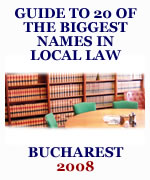Going large
Big infrastructure projects are the planned solution for the collapse of the capitalís traffic system
 |
|
|||||||||||||
Traffic jams, car accidents, angry drivers and nervous pedestrians are the main characteristics of public space in Bucharest today.
The streets of the Capital are too narrow for the large number of cars that have increased in the last 19 years since Romania became a democratic country. Until a few years ago none of the local authorities in Bucharest created a strategic plan to solve the problem of the heavy traffic in Bucharest, which is still in danger of bringing the city to deadlock.
Currently, there are 1.2 million cars for two million inhabitants. This year the number of cars will increase by 100,000 more while, in 2012, there will be 1.6 million cars on the Capital’s streets, according to the Car Registration Office.
However there are only 400,000 car parking spaces for this number. This means there is a shortfall of at least 0.8 million spaces in the city. But this does not take into account the fact that many drivers will need a space for home, work and shopping. Nor does it include spaces for the 50,000 vehicles that every day transit the city.
The main works on the road infrastructure network of Bucharest were made for the rehabilitation and reconstruction of the streets. But this has not taken into account a plan to unblock the city. The solution is to make studies able to give a prognosis on the traffic conditions over the next period, but also to create a strategy for big infrastructure projects that do not have to be finished in the mandate of one mayor or another.
“Bucharest is difficult to manage,” says Marius Bostan, senior partner for consulting company VMB Partners. “The bureaucratic structure of the city and the city planning is complicated and the responsibilities between the authorities of the six districts and the General City Hall are unclear. The public pressure is also high because of the large number of inhabitants and cars.”
'1') {
require('php/art_auth.inc');
}
?>
Eight years ago an increase in traffic jams was predicted. Now the city can already see construction works on tunnels, fly-overs, parking spaces or enlargements to the main boulevards and the metro network. But Bostan says the complex infrastructure projects will take many years to implement.
Romeo Botocan, executive manager at Max Boegl Romania, says there is some distortion of information in the press due to political infighting. He explains that when a construction company signs contracts for infrastructure projects under a controversial politician’s mandate, the press attacks the politician by saying that the construction company he hired is not doing a good job.
“It is difficult to be caught in a political fight even though you have nothing to do with it,” he says. “We offer quality, we respect the given deadlines and we don’t care under which political regime we are active.”
Foreign construction companies are favoured in auctions by the local or central authorities when it comes to complex infrastructure projects. The main conditions to win such projects are to have a solid portfolio and a high turnover. For example, Max Boegl won the auction to construct from scratch a new national stadium in Bucharest.
But the company has a history of constructing in the past stadiums in Frankfurt, Cologne, Dubai and also the Allianz Arena in Munich for the 2006 Football World Cup.
Price of development
The inhabitants of Bucharest have been suffocated during the last two years because of the major programme of street rehabilitation that is active all over the city.
This is, in some ways, a symptom of success. Bucharest has money for the first time to spend on infrastructure since the Revolution. In the last two years the City Hall of Bucharest has spent the 600 million Euro on the roads, the largest amount ever since 1989. Below are some of the major projects.
■ Basarab Flyover
The first important infrastructure project in Bucharest, the ‘Basarab’ fly-over, started in autumn 2006 and is targeted to finish in Spring next year. The two-kilometre fly-over costs 570 million Euro and is constructed by an Italian-Spanish consortium made of Astaldi and FCC Construccion.
■ Exit strategy
Bucharest’s authorities have a long-term plan to construct 21 exits from Bucharest. This is a necessity because every Friday evening or on Saturday mornings long queues are formed by drivers leaving the Capital. The worst traffic jams are created in the North, on Bucharest’s exit to the mountains, on the exit to the Sun motorway (A2) towards Constanta and on the exit to Bucuresti-Pitesti motorway in the West. Two fly-overs in Baneasa and one in Otopeni have been constructed in the north city where the biggest traffic problems emerge.
■ Motorway exits
A new eight kilometre exit to Bucuresti-Pitesti (A1) motorway, worth 143 million Euro, will start to be constructed this year by Max Boegl, Astaldi and Tehnologica Radion. The biggest section will be a fly-over between Blvd Splaiul Independentei, Ciurel Lake and the A1 motorway. The works are due to be finished in two and a half years since the contract was signed in last November. A similar project will soon start on the exit to the A2 motorway. The City Hall will spend around 60 million Euro to connect Splaiul Unirii to the Sun Motorway. The auction was won also by Max Boegl and Astaldi but was contested in court by another bidder. “We hope the legal proceedings will end so we can start the construction works this Spring,” says Romeo Botocan, Max Boegl.
■ Southern changes
A fly-over is under construction also in the south in order to connect Blvd Doamna Ghica with Blvd Chisinau. The City Hall also intends to ease the traffic in Drumul Taberei by extending the metro, but the underground is, for the moment, under the jurisdiction of the Ministry of Transport.
■ Under offer
City Hall intends to construct the first underpass after 1989, worth 50 million Euro, in the Drumul Taberei area, at the Razoare crossroad. Underpasses below the crossroads at Obor and Piata Muncii are now being reconstructed.

















